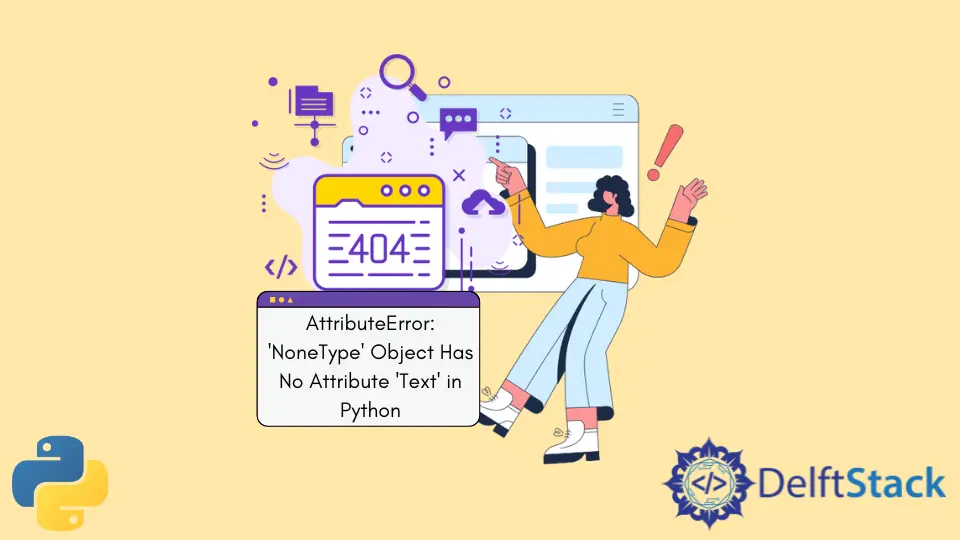How to Fix AttributeError: 'NoneType' Object Has No Attribute 'Text' in Python
- Understanding the Error
- Method 1: Check for None Before Accessing Attributes
- Method 2: Use Try-Except Blocks for Error Handling
- Method 3: Validate Function Return Values
- Conclusion
- FAQ

If you’ve been coding in Python for any length of time, chances are you’ve stumbled upon the dreaded AttributeError: ‘NoneType’ object has no attribute ’text’. This error can be frustrating, especially if you’re unsure why it’s occurring. At its core, this error signifies that you’re attempting to access an attribute or method on an object that is currently set to None.
In this article, we’ll explore the common scenarios that lead to this error and provide you with practical solutions to fix it. Whether you’re parsing HTML with BeautifulSoup or dealing with APIs, understanding how to handle NoneType objects is crucial for robust Python programming. Let’s dive in!
Understanding the Error
Before we jump into the solutions, it’s essential to understand what causes this error. The AttributeError occurs when you try to access an attribute or method on an object that is None. For example, if you expect a function to return a string but it returns None instead, attempting to call a method like .text on that None value will trigger this error. It’s a common pitfall, especially when dealing with data that may not always be present or when parsing web content.
Method 1: Check for None Before Accessing Attributes
One of the simplest and most effective ways to avoid this error is to check if the object is None before trying to access its attributes. This can be done using a simple if statement. Here’s how you can implement this approach:
response = None # Simulating a None response
if response is not None:
text_content = response.text
else:
text_content = "No content available"
print(text_content)
Output:
No content available
In this example, we simulate a situation where the response variable is None. Before trying to access the text attribute, we check if response is not None. If it is None, we assign a default message to text_content. This prevents the AttributeError from occurring and allows your program to handle the situation gracefully. Always remember to validate your data before accessing its properties, especially when dealing with external sources or APIs where the response might be unpredictable.
Method 2: Use Try-Except Blocks for Error Handling
Another effective method to deal with this error is using try-except blocks. This approach allows you to catch the error and handle it gracefully instead of crashing your program. Here’s an example of how to implement this:
response = None # Simulating a None response
try:
text_content = response.text
except AttributeError:
text_content = "No content available"
print(text_content)
Output:
No content available
In this code snippet, we attempt to access the text attribute of the response object. If response is None, Python raises an AttributeError, which we catch in the except block. Instead of the program crashing, we assign a default message to text_content. This method is particularly useful when you’re unsure whether the object will always be valid, providing a safety net for your code. Using try-except blocks can make your code more robust and user-friendly.
Method 3: Validate Function Return Values
If you’re getting a None value from a function, it’s essential to validate the return value before proceeding. This is especially important when working with functions that might not always return a valid object. Here’s an example:
def get_response():
return None # Simulating a function that returns None
response = get_response()
if response is None:
print("Function returned None")
else:
text_content = response.text
print(text_content)
Output:
Function returned None
In this example, the get_response function is designed to return None. Before trying to access the text attribute, we check if the response is None. This way, we can handle the situation accordingly and avoid the AttributeError. Validating return values is a good practice that not only helps in avoiding errors but also makes your code cleaner and easier to understand.
Conclusion
Encountering the AttributeError: ‘NoneType’ object has no attribute ’text’ can be a daunting experience for many Python developers. However, by implementing strategies such as checking for None before accessing attributes, utilizing try-except blocks, and validating function return values, you can effectively handle this error. These practices not only enhance the robustness of your code but also improve the overall user experience. Remember, proactive error handling is key to becoming a more efficient and reliable programmer. Happy coding!
FAQ
-
What causes the AttributeError: ‘NoneType’ object has no attribute ’text’?
This error occurs when you attempt to access an attribute or method on an object that is currently set to None. -
How can I prevent this error in my code?
You can prevent this error by checking if the object is None before accessing its attributes or by using try-except blocks for error handling. -
Is it safe to ignore this error in my program?
Ignoring this error is not advisable, as it can lead to crashes or unexpected behavior in your application. Always handle potential None values appropriately. -
Can this error occur when working with APIs?
Yes, this error can occur when dealing with APIs, especially if the API response is not guaranteed to return valid data. -
What is the best practice for handling NoneType objects?
The best practice is to validate your data before accessing its properties and to use error handling techniques to manage unexpected None values.
Related Article - Python Error
- Can Only Concatenate List (Not Int) to List in Python
- How to Fix Value Error Need More Than One Value to Unpack in Python
- How to Fix ValueError Arrays Must All Be the Same Length in Python
- Invalid Syntax in Python
- How to Fix the TypeError: Object of Type 'Int64' Is Not JSON Serializable
- How to Fix the TypeError: 'float' Object Cannot Be Interpreted as an Integer in Python
